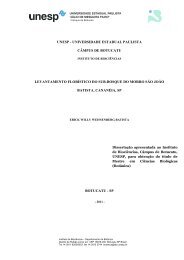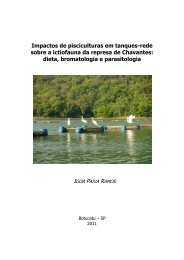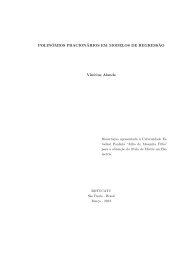Visualizar Tese - Instituto de Biociências - Unesp
Visualizar Tese - Instituto de Biociências - Unesp
Visualizar Tese - Instituto de Biociências - Unesp
You also want an ePaper? Increase the reach of your titles
YUMPU automatically turns print PDFs into web optimized ePapers that Google loves.
Andreo Fernando AguiarMHC and fiber-type. Similar to previous resistance training studies (31, 12, 52,25), our experiment found a fiber IIX/D-to-IIA type and MHCIIx/d-to-IIa conversionafter 12 weeks of RT (Table 3 and Fig. 7C). Sharman et al. (52) argue that theMHCIIx/d-to-MHCIIa isoforms conversion occurs due to the plasticity of MHCIIx/d toadjust toward more oxidative fibers. This is due to recruitment of fibers with highthresholdstimulation during strength training. The increase in MHCIIa isoforms contentshow a beneficial adaptation of the muscle fibers towards a phenotype functionally andmetabolically more efficient during training. Interestingly, the muscle fiber IIX/D(MHCIIx/d)-to-IIA (MHCIIa) transition has been similarly <strong>de</strong>monstrated inbodybuil<strong>de</strong>rs (30) and untrained individuals un<strong>de</strong>rgoing RT (31), indicating that themagnitu<strong>de</strong> of fiber-types changes is not directly related to the level of training.Collectively, our results together with of others (30, 31) suggest that there is a maximallimit of fiber-type transition in response to resistance training, which occurs only amongthe fast isoforms (IIx/d toward IIa). In addition, the increase of muscle fibers CSAduring 8 weeks (Fig. 6E) was not associated with changes in fiber frequency (Fig. 7C)and MHC content (Table 3), indicating that different stimulus of training are required toinduce muscle fibers hypertrophy and transition. Thus, the data strongly suggest that thestimulus (e.g., intensity and/or duration) of training required to induce muscle fiber-typetransition need to be greater than that to promote hypertrophy.While the morphologic and phenotypic responses to RT have been well<strong>de</strong>scribed, the exact molecular mechanisms un<strong>de</strong>rlying fiber-type transition during longtermRT are not completely un<strong>de</strong>rstood. Previous acute-resistance training studies haveshown a positive correlation between MHC isoforms, MRFs and IGF-I mRNAexpression (40, 62, 61), suggesting that the expression pattern of different MHCisoforms can be influenced by the MRFs and IGF gene expression. In our study, theupregulation in myogenin, MyoD and IGF-I mRNA expression after 8 weeks of training(Fig. 9B and C) was not associated with changes in muscle fibers-type frequency (Fig.7C) and MHC content (Table 3). Contrary to other studies (40, 62, 61) our data showthat the increased in myogenin, MyoD and IGF-I mRNA expression was not associatedwith MHC modulation and muscle fiber-type transition. Corroborating our findings,Rudnicki et al. (50) showed that the expression of slow and fast fiber types was notprevented in mice by a knockout of MyoD gene. In addition, electrical stimulationstudies in fast muscle were not accompanied by conspicuous changes in MyoD andmyogenin mRNA levels (42, 32). So, the function of MRFs controlling the MHC63
















